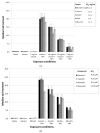Improved Preventive Effects of Combined Bioactive Compounds Present in Different Blueberry Varieties as Compared to Single Phytochemicals
- PMID: 30597948
- PMCID: PMC6356906
- DOI: 10.3390/nu11010061
Improved Preventive Effects of Combined Bioactive Compounds Present in Different Blueberry Varieties as Compared to Single Phytochemicals
Abstract
Blueberries contain many different phytochemicals which might be responsible for their disease preventive properties. In a previously conducted human dietary intervention study, we showed that a 4-week intervention with blueberry⁻apple juice protected the participants against oxidative stress and modulated expression of genes involved in different genetic pathways contributing to the antioxidant response. The present study investigates the effect of different blueberry varieties (Elliot, Draper, Bluecrop, and Aurora, and the blueberry⁻apple juice from our previous human dietary intervention study), and four different single compounds (vitamin C, peonidin, cyanidin, and quercetin) on antioxidant capacity and gene expression changes in colonic cells in vitro, and compares the outcome with the earlier in vivo findings. The results demonstrate that all blueberry varieties as well as the blueberry⁻apple juice were more effective in reducing oxidative stress as compared to the single compounds (e.g., DNA strand break reduction: EC50: Elliot 8.3 mg/mL, Aurora and Draper 11.9 mg/mL, blueberry⁻apple juice 12.3 mg/mL, and Bluecrop 12.7 mg/mL; single compounds). In addition, the gene expression profiles (consisting of 18 selected genes from the in vivo study) induced by the blueberry varieties were more similar to the profile of the human intervention study (range 44⁻78%). The blueberry variety Elliot showed the strongest and most similar effects, almost 80% of gene expression modulations were similar compared to the in vivo results. From the single compounds (range 17⁻44%), quercetin induced the most comparable gene expression changes, i.e., 44%. This approach could be useful in agriculture for identifying crop varieties containing combinations of phytochemicals which show optimal preventive capacities.
Keywords: (combinations of) phytochemicals; antioxidant capacity; blueberry extracts; disease risk reduction; gene expression profiles.
Conflict of interest statement
The authors declare no conflict of interest.
Figures




Similar articles
-
The Effects of Blueberry Phytochemicals on Cell Models of Inflammation and Oxidative Stress.Adv Nutr. 2022 Aug 1;13(4):1279-1309. doi: 10.1093/advances/nmab137. Adv Nutr. 2022. PMID: 34791023 Free PMC article. Review.
-
Comparison of phytochemical profiles, antioxidant and cellular antioxidant activities of different varieties of blueberry (Vaccinium spp.).Food Chem. 2017 Feb 15;217:773-781. doi: 10.1016/j.foodchem.2016.09.002. Epub 2016 Sep 3. Food Chem. 2017. PMID: 27664697
-
Can transcriptomics provide insight into the chemopreventive mechanisms of complex mixtures of phytochemicals in humans?Antioxid Redox Signal. 2014 May 10;20(14):2107-13. doi: 10.1089/ars.2013.5528. Epub 2014 Feb 27. Antioxid Redox Signal. 2014. PMID: 24328558 Free PMC article. Clinical Trial.
-
Regulation of redox status in neuronal SH-SY5Y cells by blueberry (Vaccinium myrtillus L.) juice, cranberry (Vaccinium macrocarpon A.) juice and cyanidin.Food Chem Toxicol. 2018 Aug;118:572-580. doi: 10.1016/j.fct.2018.05.066. Epub 2018 Jun 1. Food Chem Toxicol. 2018. PMID: 29860017
-
Molecular Mechanism and Health Role of Functional Ingredients in Blueberry for Chronic Disease in Human Beings.Int J Mol Sci. 2018 Sep 16;19(9):2785. doi: 10.3390/ijms19092785. Int J Mol Sci. 2018. PMID: 30223619 Free PMC article. Review.
Cited by
-
The Effects of Blueberry Phytochemicals on Cell Models of Inflammation and Oxidative Stress.Adv Nutr. 2022 Aug 1;13(4):1279-1309. doi: 10.1093/advances/nmab137. Adv Nutr. 2022. PMID: 34791023 Free PMC article. Review.
-
Fluctuations of Histone Chemical Modifications in Breast, Prostate, and Colorectal Cancer: An Implication of Phytochemicals as Defenders of Chromatin Equilibrium.Biomolecules. 2019 Dec 5;9(12):829. doi: 10.3390/biom9120829. Biomolecules. 2019. PMID: 31817446 Free PMC article. Review.
-
A deep dive into the orchard of health: Exploring the anti-cancer and anti-aging potential of apple polyphenols.J Food Drug Anal. 2025 Mar 31;33(1):1-12. doi: 10.38212/2224-6614.3539. J Food Drug Anal. 2025. PMID: 40202408 Free PMC article. Review.
-
Addressing Mental Health in Rural Settings: A Narrative Review of Blueberry Supplementation as a Natural Intervention.Nutrients. 2024 Oct 18;16(20):3539. doi: 10.3390/nu16203539. Nutrients. 2024. PMID: 39458533 Free PMC article. Review.
-
Blueberry Consumption Challenges Hepatic Mitochondrial Bioenergetics and Elicits Transcriptomics Reprogramming in Healthy Wistar Rats.Pharmaceutics. 2020 Nov 14;12(11):1094. doi: 10.3390/pharmaceutics12111094. Pharmaceutics. 2020. PMID: 33202669 Free PMC article.
References
-
- World Cancer Research Fund. American Institute for Cancer Research . Nutrition, Physical Activity, and the Prevention of Cancer: A Global Perspective. American Institute for Cancer Research; Washington, DC, USA: 2007. p. 517.
-
- Kok T.M., Breda S.G., Briede J.J. Genomics-based identification of molecular mechanisms behind the cancer preventive action of phytochemicals: Potential and challenges. Curr. Pharm. Biotechnol. 2012;13:255–264. - PubMed
MeSH terms
Substances
LinkOut - more resources
Full Text Sources
Molecular Biology Databases

